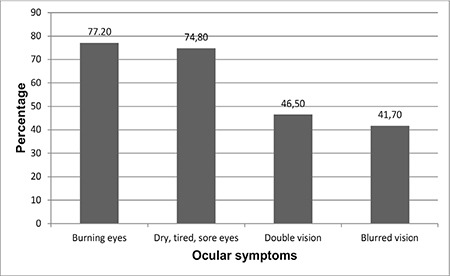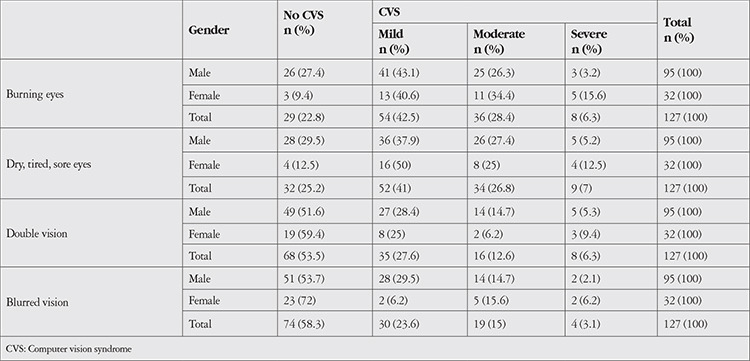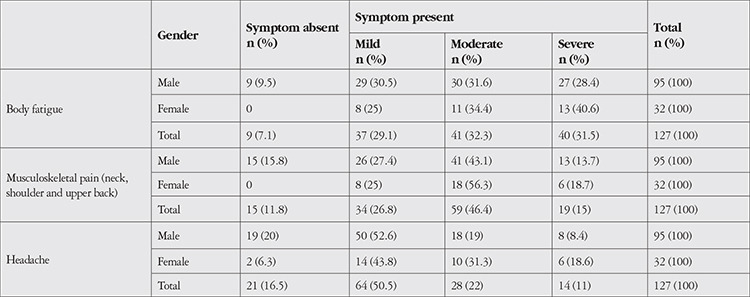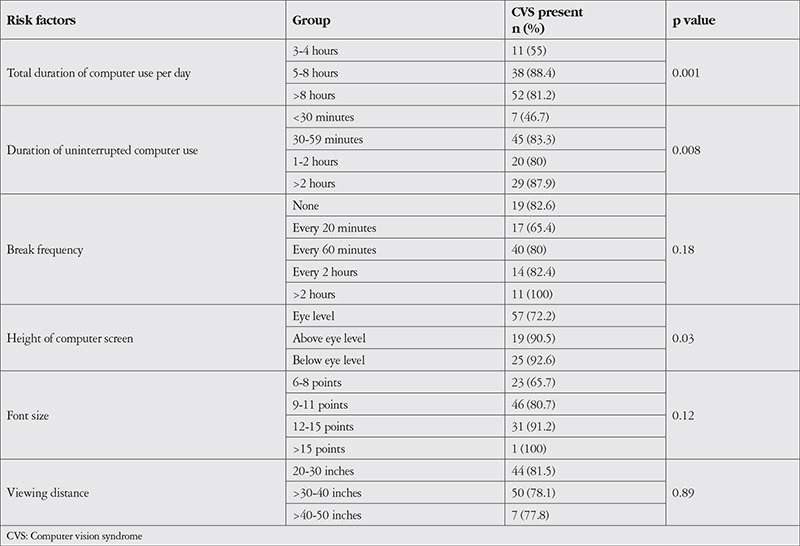Abstract
Objectives:
The aim of this study was to investigate the prevalence of symptoms of computer vision syndrome (CVS) and identify its associated risk factors among computer-using bank workers in Pakistan.
Materials and Methods:
This cross-sectional study was conducted on computer-using bank workers. The data collection procedure included a self-administered questionnaire and comprehensive ocular health examination. The prevalence of CVS and its associated risk factors were investigated. The chi-square test was used to study the significance of the association of CVS with potential risk factors.
Results:
Of 127 participants, 95 (74.8%) were men. Most of the participants (n=53; 41.7%) were in the 30-40 years age group. A total of 101 participants (79.5%) reported any ocular symptom, with burning eyes being the most frequent ocular symptom (77.2%). General body fatigue was the most common non-ocular symptom of CVS (92.9%), followed by headache (83.5%). Out of 127 participants, 71 men and 30 women had some degree of CVS. Female participants had significantly higher risk of CVS than male participants (p=0.01). Total duration of computer use per day and duration of uninterrupted computer use were significantly associated with the occurrence of CVS (p=0.001 and p=0.008, respectively). No significant association was found between CVS and distance from computer screen (p=0.89), frequency of breaks (p=0.18), or font size (p=0.12).
Conclusion:
A high prevalence of CVS-related symptoms was observed among computer-using bank workers. Non-ocular symptoms associated with computer use were more common than ocular symptoms (92.9% vs. 77.2%).
Keywords: Computer vision syndrome, ocular symptoms, non-ocular symptoms, risk factors, bank workers
Introduction
Computers are one of the major scientific advances and their use for academic, professional, and social activities has become an essential part of our everyday life. Computer use improved work efficiency and quality. During the Coronavirus disease 2019 pandemic, the academic, professional, and social use of computers increased significantly worldwide. Although the computer has revolutionized our lives in every aspect, prolonged use leads to ocular and general health-related problems such as eye strain, dry eyes, irritation, redness, temporary blurred vision, tired eyes, headache, back pain, and fatigue.1,2,3,4 Computer-related ocular problems are collectively called computer vision syndrome (CVS). CVS is defined by the American Optometric Association as a group of eye and vision problems related to prolonged use of computers and other handheld screened devices.5
CVS occurs when the demands of the visual task exceeds the person’s visual ability.5 The prevalence of CVS among computer users is reported to be 60% to 90%.6,7,8 It has been estimated that with an annual increase of one million, nearly 60 million people experience CVS worldwide.9 CVS is not only a prevailing issue in developed countries, but also a growing public health problem in developing countries. A higher prevalence of CVS has been reported in medical students (95%) and among computer-using office workers (67.4%) in developing countries.10,11 It was also reported that 14.25% of people visiting eye care professionals for ocular examination have symptoms related to CVS.12
There are no documented cases of permanent visual damage due to extensive computer use. However, prolonged computer use while maintaining a single posture is a known predictor for developing CVS and musculoskeletal problems.11,13,14 Research has shown that CVS-related symptoms reduce work productivity.7,10 Hence, it is likely that an increase in the prevalence of CVS will not only lead to more CVS-related health issues but also cause a significant decline in workforce productivity. The personal computer is one of the most essential office tools for workers in banks. In view of the limited published reports on CVS in this group, the present study was conducted among computer-using bank workers in the city of Peshawar to investigate the prevalence of CVS and its associated risk factors among computer-using bank workers.
Materials and Methods
Ethical Approval
Ethical approval was obtained from the Institutional Research and Ethics Committee. Data were collected after the approval of the manager of the bank with the assurance that each participant had the full right to participate, refuse, or withdraw at any time. After explaining the purpose of the study, written signed consent was obtained from each of the computer operators.
Study Population and Sampling
This cross-sectional study was conducted on computer-using employees working in private and public sector banks in Peshawar, Pakistan. This group of office workers was chosen because they are at greater risk of developing CVS due continuous computer work.8 According to the data provided by the State Bank of Pakistan office in Peshawar, there are 31 governmental and non-governmental bank brands providing services in Peshawar with a combined total of 290 branches at different locations in the city. Of the 31 bank brands, 18 had five or more branches while 13 brands had fewer than five branches in Peshawar. The 13 bank brands with fewer than five branches were excluded from the study. Of the remaining 18 bank brands, six brands were selected, three from the government/public sector and three brands from private sector. Five branch offices from each of these bank brands were randomly selected for this study, resulting in a total of 30 banks with 132 computer-using employees.
All computer-using bank workers who had worked at the bank for a minimum of 1 month and used a computer at work for at least 3 hours daily were considered eligible to participate in the study.15 Employees with corrected visual acuity less than 6/6, any ocular disease such as glaucoma, diabetic retinopathy, hypertensive retinopathy, cataract, age-related macular degeneration, central retinal artery/vein occlusion, or any other illness such as migraine or a diagnosed muscular disorder were excluded from the study.
The sampling frame was confirmed with permission of the bank manager before data collection from the computer-using bank workers in the selected banks. Ophthalmic examination of each participant was conducted by a trained optometrist. The examination included visual acuity, history and demographic profile, hours of computer work per day, ophthalmoscopy, and symptoms of CVS. The Snellen visual acuity chart was used for visual acuity measurement. Anterior segment examination was performed using a penlight and handheld slit-lamp biomicroscope. Posterior segment examination was conducted using direct ophthalmoscope after mydriasis. After the detailed interview and ophthalmic examination, 127 computer-using bank workers were eligible for the study.
Data Collection Tool and Procedures
A pre-tested validated questionnaire was used for data collection. The first section of the questionnaire consisted of demographic information such as name, age, gender, and work address. The next section consisted of risk factors associated with CVS such as the employees’ daily hours of computer use, breaks, use of any glasses or contact lenses for refractive error correction, typical font size used, screen position, and viewing distance. The third section consisted of ocular and non-symptoms of CVS. Ocular symptoms included eye pain and fatigue, burning, dryness, double vision, and blurred vision. Non-ocular symptoms included headache, total body fatigue, and musculoskeletal pain including neck, shoulder, and back pain. The participants were asked to rate their level of discomfort as none, mild, moderate, or severe (scored as 0 to 3).
Statistical Analysis
Data were analyzed using IBM SPSS Statistics version 21 (IBM Corp, Armonk, NY, USA). Descriptive statistics tools were used to investigate the prevalence of CVS among bank workers and the association of CVS with other variables such as daily duration of computer use, duration of uninterrupted computer use, screen viewing distance and position, and font size. Chi-square test was used to study the significance of associations. P values <0.05 were considered statistically significant.
Results
A total of 127 computer operators from 30 banks (15 in the private sector and 15 in the public sector) in Peshawar participated in this study. Ninety-five (74.8%) of the participants were men (male to female ratio 3:1). Most of the participants (n=53; 41.7%) were in the 30-40 years age group. The demographic characteristics of participants working in the selected private and public sector banks are given in Table 1.
Table 1. Demographics of the participants.

Among the participants, 19.7% (n=25) used glasses and 5.5% (n=7) used contact lenses for vision correction. In regards to ocular symptoms, the prevalence of any ocular symptom of CVS was 79.5% (n=101). Eye burning was reported by more than three quarters of the participants (77.2%). The prevalence of ocular symptoms of CVS reported by participants is shown in Figure 1.
Figure 1.

Frequency of ocular symptoms amongst computer operators
Out of 127 participants, 71 men and 30 women had some degree of CVS. Female participants had a significantly higher risk of CVS than male participants (p=0.01). Regarding ocular symptoms of CVS, 74.7% of men and 93.8% of women had at least one symptom of CVS during working hours. Details about the severity of ocular symptoms of CVS in computer-using bank workers are given in Table 2.
Table 2. Severity of ocular symptoms among computer-using bank workers.

The most frequently reported non-ocular symptom associated with the use of computer was general body fatigue (92.9%). This was followed by neck, shoulder, and back pain (88.2%), while 106 participants (83.5%) reported headache. The frequency and severity of non-ocular symptoms among computer-using bank workers are shown in Table 3.
Table 3. Frequency of non-ocular symptoms related to computer use.

The association between the presence of CVS and each risk factor was analyzed. The results showed a significant correlation between CVS and total duration of computer use per day (p<0.001), duration of uninterrupted computer use (p=0.01), and the height of the computer screen relative to the eyes (p=0.03). Factors which were not significantly associated with CVS included screen viewing distance (p=0.89), frequency of work breaks (p=0.18), and font size (p=0.12).
Of the 64 participants (50.4%) who used a computer for more than 8 hours per day, 81.2% had symptoms of CVS. In contrast, only 11 (55%) of the 20 participants with 3-4 hours of computer use per day experienced CVS. Details about the association between risk factors and CVS are shown in Table 4.
Table 4. Association between risk factors and computer vision syndrome.

Discussion
The present study investigated the prevalence of CVS and risk factors for developing CVS among computer-using bank workers. The results of this study demonstrate that non-ocular symptoms associated with computer use were more common among bank workers than ocular symptoms (92.9% vs. 79.5%). Eye burning was the most frequent ocular symptom of CVS experienced by the participants (77.2%). In regards to non-ocular symptoms, general body fatigue was the most frequent computer-related problem, reported by 92.9% of participants. More than 8 hours of computer use per day was a significant predictor for CVS (p=0.001). Female participants had a significantly higher risk of CVS than male participants (p=0.01).
Our findings revealed a high prevalence (79.5%) of ocular symptoms of CVS among computer-using bank workers. Studies on the prevalence of CVS in office workers from Nigeria and Ethiopia reported similar results (74% and 73%, respectively).16,17 In contrast to the present study, a lower prevalence of CVS (51.1%) was reported in different groups of computer users among the university administrative staff in Ghana.14 Most of the participants in the Ghana study were in the 25-35 years age group (age range: 19-39 years). Another study including university employees as well as public and private sector workers in Mauritius reported a CVS prevalence of 59.5%.18 That study included participants aged 19-60 years who used a computer for 1 hour or more. The younger participants and shorter duration of computer use in these studies compared to our study may be the reason for the lower prevalence rates. Some other studies on the prevalence of CVS reported higher rates than in the present study. For instance, Reddy et al.19 reported a prevalence of 89.9% among university students in Malaysia and Hassan et al.20 reported a prevalence of 90.5% among medical students. Another study from Saudi Arabia reported that 95% of undergraduate medical students experience at least one symptom of CVS.10 The higher prevalence of CVS observed in these studies indicates that CVS is more common among students.
Results from the present study showed that more than three quarters of participants were suffering from eye burning (77.2%). Similar to findings from the present study, burning eyes was the most frequent moderate symptom experienced by participants in a study of CVS among university administrative staff in Ghana.14 Another study conducted on CVS reported 79.1% prevalence of eye burning among ophthalmologists in India.21 In contrast, a study from Pakistan reported 33% prevalence of eye burning among undergraduate medical students.22 The reason for the lower prevalence of eye burning among students may be that students are usually younger and have more opportunities to take breaks and relax their eyes.
The most prevalent non-ocular symptom reported by the participants in this study was body fatigue (92.9%). This is in line with the result of a study conducted in Nigeria reporting greater prevalence of musculoskeletal symptoms than ocular symptoms related to computer use.23 A possible explanation for the higher prevalence of non-ocular symptoms in our study may be that bank workers relax their eyes while talking to clients but hold the same body position for long periods of time. In the present study, 88.2% of participants reported neck, shoulder, and upper back pain. A related study conducted on female undergraduate students in Saudi Arabia reported neck or shoulder pain as the most common non-ocular symptoms of computer users, experienced by 82.2% of the participants.6 Another study from Nigeria reported neck and shoulder pain as the most frequent non-ocular problem (62%) among computer users.23 That study included bankers, office workers, and students. The broader category of participants in that study may explain the lower prevalence of non-ocular symptoms of CVS compared to the present study.
Headache was another common symptom in our study, reported by 83.5% of participants. A similar rate (82.1%) was reported in a study conducted on the prevalence of CVS among ophthalmologists in India.21 A study conducted in Ghana reported headache as the most frequent severe CVS symptom among university administrative staff.#*#ref14#*# Related studies conducted on CVS in Nigeria and Ethiopia reported the prevalence of headache to be 58.4% and 33.65%, respectively.17,23 The participants in these studies ranged from students to office workers, bankers, and civil and public servants. A study from Sri Lanka reported headache as the most common symptom of CVS among participants, with a prevalence of 45.7%.11 The low prevalence in the study from Sri Lanka compared to the present study may be related to the fact that the Sri Lanka study included the 1-year prevalence of CVS.
A significant association between CVS and duration of computer use per day was observed in this study (p=0.001). Our findings showed that participants who use a computer for 8 hours are at greater risk of developing CVS. Similarly, a higher prevalence of CVS was reported among people in Nigeria who spend more than 8 hours daily at a computer.24 A study from New York also showed that CVS was associated with the duration of computer use.25 Other similar studies demonstrated the same relationship.11,26
Some authors have reported a significant association between the frequency of work breaks and CVS.20,27 In contrast, some other studies demonstrated no significant relationship between break frequency and CVS.10,11 Findings from the present study suggest that the frequency of work breaks is not significantly associated with CVS (p=0.18). This may be because bank employees work in small cubicles and have less opportunity to relax their eyes even during break time.
In the present study, the male participants outnumbered the females 3 to 1. This is because women are underrepresented in all offices and organizations in Pakistan. However, in regard to gender, our results showed that women are at greater risk of developing symptoms of CVS than men (93.8% vs. 74.7%; p=0.01). Similar to the findings from this study, a higher prevalence of CVS among female office workers has also been reported in other studies.11,18
Study Limitations
The limitation of this study was that clinical tests were not performed for the categorization of mild, moderate, and severe dry eye. Participants were asked to rate their level of discomfort related to ocular dryness as none, mild, moderate, or severe.
Conclusion
The symptoms of CVS were common among computer-using bank workers. Non-ocular symptoms associated with computer use were more prevalent than ocular symptoms (92.9% vs. 79.5%). The issue of CVS must be minimized to reduce the discomfort experienced by computer users.
Footnotes
Ethics
Ethics Committee Approval: Ethical approval was obtained from the Institutional Research and Ethics Committee. Data were collected after approval from the manager of the bank with the assurance that each participant had full right to participate, refuse or withdraw at any time.
Informed Consent: After explaining the purpose of the study, written signed consent was obtained from each computer operator.
Peer-review: Externally peer-reviewed.
Authorship Contributions
Concept: M.S., A.S., Design: M.S., A.S., Data Collection or Processing: M.S., A.S., Analysis or Interpretation: M.S., A.S., Literature Search: M.S., A.S., Writing: M.S., A.S.
Conflict of Interest: No conflict of interest was declared by the authors.
Financial Disclosure: The authors declared that this study received no financial support.
References
- 1.Baig MA, Munir R, Munir W. Computer vision syndrome: a rising occupation hazard. Pak J Med Res. 2019;58:31–34. [Google Scholar]
- 2.Lee YK, Chang CT, Lin Y, Cheng ZH. The dark side of smartphone usage: Psychological traits, compulsive behavior and technostress. Comput Human Behav. 2014;31:373–383. [Google Scholar]
- 3.Gowrisankaran S, Sheedy JE. Computer vision syndrome: a review. Work. 2015;52:303–314. doi: 10.3233/WOR-152162. [DOI] [PubMed] [Google Scholar]
- 4.Mowatt L, Gordon C, Santosh ABR, Jones T. Computer vision syndrome and ergonomic practices among undergraduate university students. Int J Clin Pract. 2018;72:e13035. doi: 10.1111/ijcp.13035. [DOI] [PubMed] [Google Scholar]
- 5.Association AO. The effects of computer use on eye health and vision. [02 August 2011]. 1997. Internet: [Internet] http://www,aoa,org/documents/EffectsComputerUse.pdf.
- 6.Al Tawil L, Aldokhayel S, Zeitouni L, Qadoumi T, Hussein S, Ahamed SS. Prevalence of self-reported computer vision syndrome symptoms and its associated factors among university students. Eur J Ophthalmol. 2020;30:189–195. doi: 10.1177/1120672118815110. [DOI] [PubMed] [Google Scholar]
- 7.Hayes JR, Sheedy JE, Stelmack JA, Heaney CA. Computer use, symptoms and quality of life. Optom Vis Sci. 2007;84:738–744. doi: 10.1097/OPX.0b013e31812f7546. [DOI] [PubMed] [Google Scholar]
- 8.Assefa NL, Weldemichael DZ, Alemu HW, Anbesse DH. Prevalence and associated factors of computer vision syndrome among bank workers in Gondar City, northwest Ethiopia, 2015. Clin Optom (Auckl). 2017;9:67–76. doi: 10.2147/OPTO.S126366. [DOI] [PMC free article] [PubMed] [Google Scholar]
- 9.Sen A, Richardson S. A study of computer-related upper limb discomfort and computer vision syndrome. J Hum Ergol (Tokyo). 2007;36:45–50. [PubMed] [Google Scholar]
- 10.Abudawood GA, Ashi HM, Almarzouki NK. Computer vision syndrome among undergraduate medical students in King Abdulaziz University, Jeddah, Saudi Arabia. J Ophthalmol. 2020;2020:1–7. [Google Scholar]
- 11.Ranasinghe P, Wathurapatha WS, Perera YS, Lamabadusuriya DA, Kulatunga S, Jayawardana N, Katulanda P. Computer vision syndrome among computer office workers in a developing country: an evaluation of prevalence and risk factors. BMC Res Notes. 2016;9:150. doi: 10.1186/s13104-016-1962-1. [DOI] [PMC free article] [PubMed] [Google Scholar]
- 12.Sheedy JE. Vision problems at video display terminals: a survey of optometrists. J Am Optom Assoc. 1992;63:687–692. [PubMed] [Google Scholar]
- 13.Shantakumari N, Eldeeb R, Sreedharan J, Gopal K. Computer use and vision. related problems among university students in Ajman, United Arab Emirate. Ann Med Health Sci Res. 2014;4:258–263. doi: 10.4103/2141-9248.129058. [DOI] [PMC free article] [PubMed] [Google Scholar]
- 14.Boadi-Kusi SB, Abu SL, Acheampong GO, Adueming PO, Abu EK. Association between poor ergophthalmologic practices and computer vision syndrome among university administrative staff in Ghana. J Environ Public Health. 2020;2020:7516357. doi: 10.1155/2020/7516357. [DOI] [PMC free article] [PubMed] [Google Scholar]
- 15.Rossignol AM, Morse EP, Summers VM, Pagnotto LD. Video display terminal use and reported health symptoms among Massachusetts clerical workers. J Occup Med. 1987;29:112–118. [PubMed] [Google Scholar]
- 16.Akinbinu TR, Mashalla Y. Knowledge of computer vision syndrome among computer users in the workplace in Abuja, Nigeria. J Physiol Pathophysiol. 2013;4:58–63. [Google Scholar]
- 17.Dessie A, Adane F, Nega A, Wami SD, Chercos DH. Computer vision syndrome and associated factors among computer users in debre tabor town, northwest Ethiopia. J Environ Public Health. 2018;2018:4107590. doi: 10.1155/2018/4107590. [DOI] [PMC free article] [PubMed] [Google Scholar]
- 18.Subratty A, Korumtollee F. Occupational overuse syndrome among keyboard users in Mauritius. Indian J Occup Environ Med. 2005;9:71–75. [Google Scholar]
- 19.Reddy SC, Low CK, Lim YP, Low LL, Mardina F, Nursaleha MP. Computer vision syndrome: a study of knowledge and practices in university students. Nepal J Ophthalmol. 2013;5:161–168. doi: 10.3126/nepjoph.v5i2.8707. [DOI] [PubMed] [Google Scholar]
- 20.Hassan A, Kashif M, Masud Z, Raza MA. Prevalence of computer vision syndrome (CVS) amongst the students of Khyber Medical University, Peshawar. Islamabad. 2017;15:59–63. [Google Scholar]
- 21.Bali J, Navin N, Thakur BR. Computer vision syndrome: a study of the knowledge, attitudes and practices in Indian ophthalmologists. Indian J Ophthalmol. 2007;55:289–294. doi: 10.4103/0301-4738.33042. [DOI] [PubMed] [Google Scholar]
- 22.Noreen K, Batool Z, Fatima T, Zamir T. Prevalence of computer vision syndrome and its associated risk factors among under graduate medical students of urban karachi. Pak J Ophthalmol. 2016;32:140–146. [Google Scholar]
- 23.Kolawole OU, Iyanda RA, Isawumi MA. Computer-related vision problems in Osogbo, south-western Nigeria. Afr J Biomed Res. 2017;20:267–272. [Google Scholar]
- 24.Chiemeke SC, Akhahowa AE, Ajayi OB. Evaluation of vision-related problems amongst computer users: a case study of university of Benin, Nigeria. World Congress on Engineering. 2007. [Google Scholar]
- 25.Portello JK, Rosenfield M, Bababekova Y, Estrada JM, Leon A. Computer-related visual symptoms in office workers. Ophthalmic Physiol Opt. 2012;32:375–382. doi: 10.1111/j.1475-1313.2012.00925.x. [DOI] [PubMed] [Google Scholar]
- 26.Logaraj M, Madhupriya V, Hegde S. Computer vision syndrome and associated factors among medical and engineering students in Chennai. Ann Med Health Sci Res. 2014;4:179–185. doi: 10.4103/2141-9248.129028. [DOI] [PMC free article] [PubMed] [Google Scholar]
- 27.Hassan HMJ, Ehsan S, Arshad HS. Frequency of computer vision syndrome & ergonomic practices among computer engineering students. Int J Sci Res. 2016;5:121–125. [Google Scholar]


